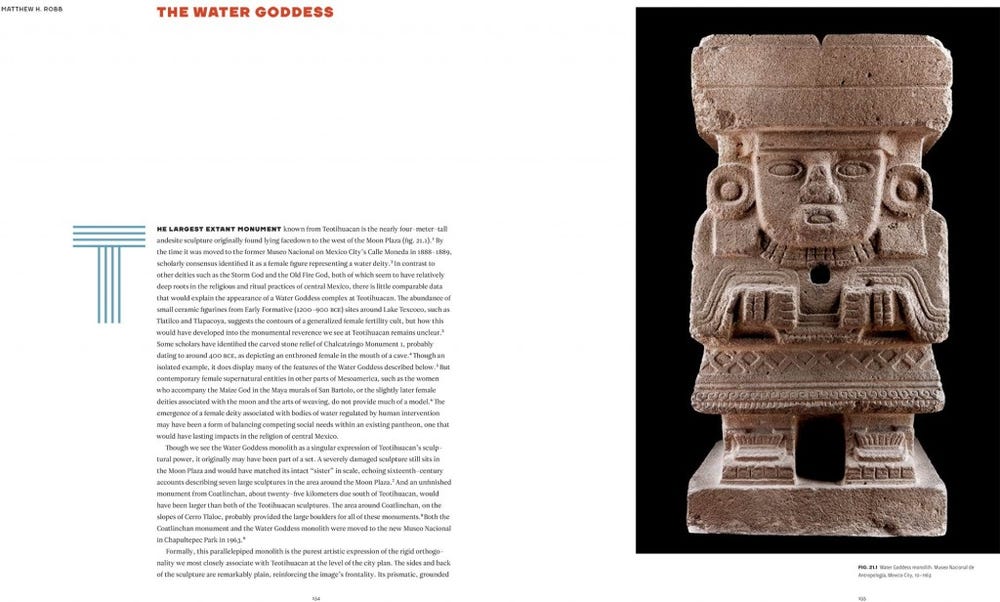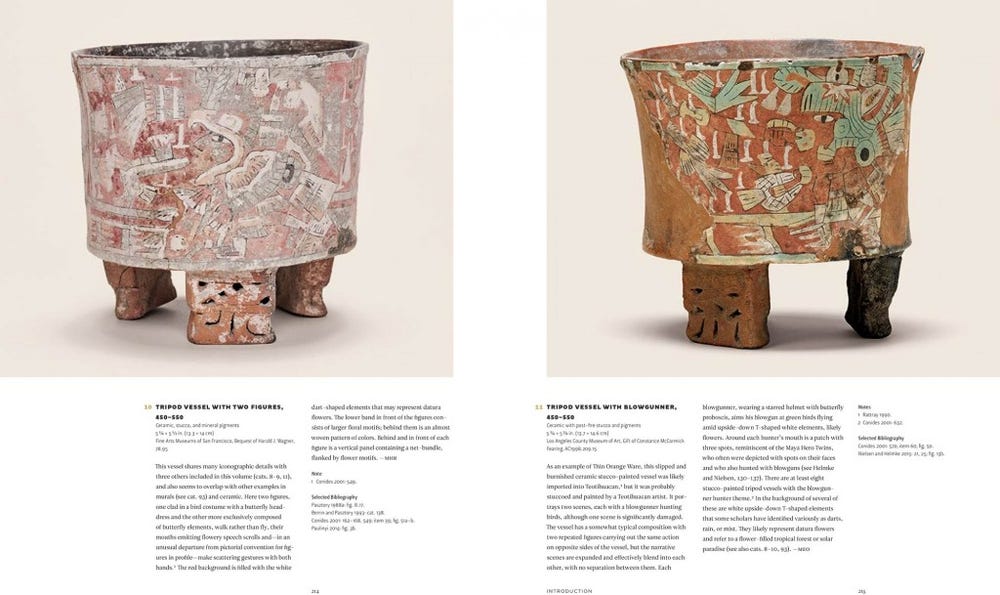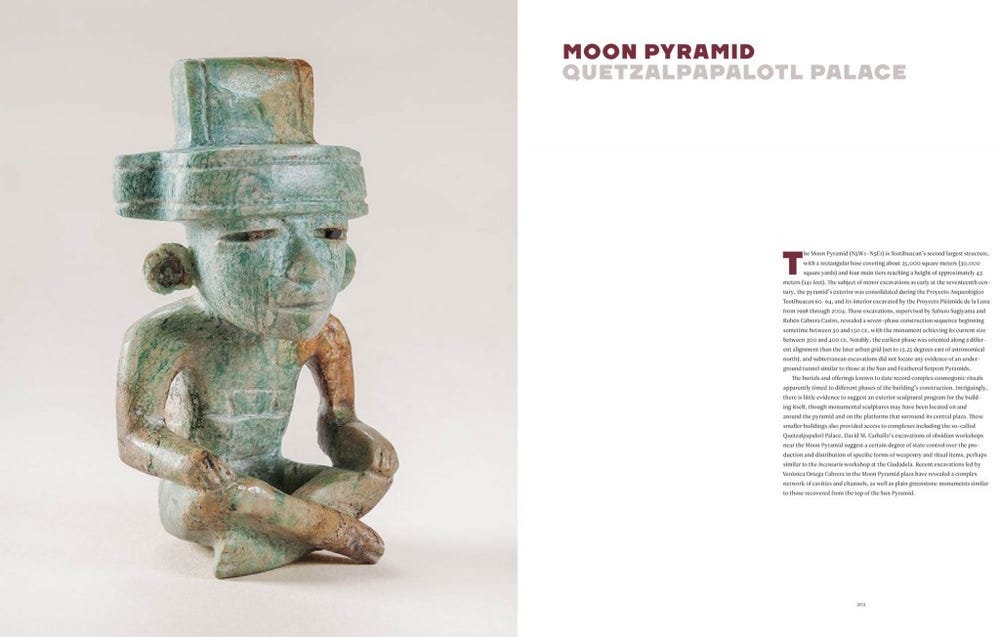Teotihuacan: City of Water, City of Fire
By Matthew H. Robb, Rubén Cabrera Castro, David M. Carballo, Erika Carrillo, George L. Cowgill, Laura Filloy Nadal, Julie Gazzola, et al.
TEOTIHUACAN—the name of this ancient Mexican city conjures visions of enormous pyramids and long avenues surrounded by mountains and volcanoes in the Valley of Mexico. But there is more to this place than meets the eye. Far beneath the Street of the Dead and its surrounding structures lie secrets that are only now coming to light.
Established in the first century BCE, Teotihuacan evolved into a major urban center, attracting a multiethnic population of one hundred thousand people. At its peak, it was the cultural, political, economic, and religious center of ancient Mesoamerica. The art and architecture its citizens left behind have been objects of fascination since the time of the Aztecs. Yet the meaning of these powerful objects and images has remained elusive. Now recent discoveries have brought us closer to understanding the importance of this art to the citizens of Teotihuacan.
Published to accompany a major exhibition at the de Young Museum in San Francisco and the Los Angeles County Museum of Art, Teotihuacan: City of Water, City of Fire features essays by leading archaeologists and researchers who have studied this site. Lavish photographs of more than two hundred artifacts not only illustrate these experts’ captivating interpretations of Teotihuacano life, but also stand alone as bold and colorful remnants of a remarkable civilization.
These finely crafted works of art demonstrate how the city’s dominant ideology permeated everyday spaces, uniting a diverse population. As this volume reveals, they functioned in support of the city itself as a symbolic re-creation of the universe. Fire and water were the vital, essential forces that both powered and threatened the city through their presence or absence. The art of Teotihuacan represents, on a fundamental level, manifestations of these and other natural forces and the beings and rituals designed to bring them into cosmic balance.
Authors
Matthew H. Robb is chief curator of the Fowler Museum at the University of California, Los Angeles.
Rubén Cabrera Castro is professor emeritus, director of the Proyecto La Ventilla, and an investigator at the Zona de Monumentos Arqueológicos de Teotihuacan for the Instituto Nacional de Antropología e Historia.
David M. Carballo is associate professor in the Department of Archaeology at Boston University.
Erika Carrillo is an archaeologist at the Zona de Monumentos Arqueológicos de Teotihuacan for the Instituto Nacional de Antropología e Historia.
George L. Cowgill is professor emeritus in the School of Human Evolution and Social Change at Arizona State University.
Laura Filloy Nadal is senior conservator at the Museo Nacional de Antropología for the Instituto Nacional de Antropología e Historia.
Julie Gazzola is director of the Proyecto Primeras Ocupaciones en Teotihuacan Dirección de Estudios Arqueológicos for the Instituto Nacional de Antropología e Historia.
Sergio Gómez Chávez is an archaeologist, investigator, and director of the Proyecto Tlalocan of the Zona de Monumentos Arqueológicos de Teotihuacan for the Instituto Nacional de Antropología e Historia.
Nikolai Grube is professor in the Department for the Anthropology of the Americas at the University of Bonn.
Christophe Helmke is associate professor in the Department of Cross-Cultural and Regional Studies at the University of Copenhagen.
Leonardo López Luján is senior researcher in archaeology at the Museo del Templo Mayor and director of the Proyecto Templo Mayor for the Instituto Nacional de Antropología e Historia.
Diana Magaloni is director of the Program for Art of the Ancient Americas at the Los Angeles County Museum of Art.
Linda R. Manzanilla is an archaeologist in the Institute of Anthropological Research at the Universidad Nacional Autónoma de México and a member of El Colegio Nacional.
Jesper Nielsen is associate professor in the Department of Cross-Cultural and Regional Studies at the University of Copenhagen.
Nelly Zoé Núñez Rendon is an archaeologist at the Zona de Monumentos Arqueológicos de Teotihuacan for the Instituto Nacional de Antropología e Historia.
Hillary Olcott is assistant curator in the Department of the Arts of Africa, Oceania, and the Americas at the Fine Arts Museums of San Francisco.
Megan E. O’Neil is associate curator in the Program for Art of the Ancient Americas at the Los Angeles County Museum of Art.
Jorge Pérez de Lara Elías is an independent photographer based in Cuernavaca, Mexico.
Alejandro Sarabia González is an archaeologist, director of the Proyecto Pirámide del Sol, and director of the Zona de Monumentos Arqueológicos de Teotihuacan for the Instituto Nacional de Antropología e Historia.
Nawa Sugiyama is assistant professor in the Sociology and Anthropology Department at George Mason University.
Saburo Sugiyama is research professor in the School of Human Evolution and Social Change at Arizona State University and professor of the Graduate School of International Cultural Studies at Aichi Prefectural University.













